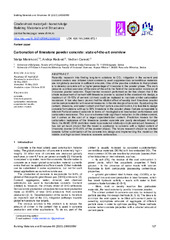Приказ основних података о документу
Carbonation of limestone powder concrete: state-of-the-art overview
| dc.creator | Marinković, Matija | |
| dc.creator | Radović, Andrija | |
| dc.creator | Carević, Vedran | |
| dc.date.accessioned | 2023-07-19T07:24:01Z | |
| dc.date.available | 2023-07-19T07:24:01Z | |
| dc.date.issued | 2023 | |
| dc.identifier.issn | 2335-0229 | |
| dc.identifier.uri | https://grafar.grf.bg.ac.rs/handle/123456789/3144 | |
| dc.description.abstract | Recently, research into finding long-term solutions to CO2 mitigation in the cement and concrete sectors was initiated since commonly used supplementary cementitious materials are not globally available in sufficient amounts. One of the possible solutions to that problem is to develop concrete with a higher percentage of limestone in the powder phase. This work presents a critical overview of the state-of-the-art in the field of the carbonation resistance of limestone powder concrete. Experimental research performed so far has shown that if the simple replacement of cement with limestone powder is applied in the standard mix design, a maximum of 10-15% of cement (clinker) could be replaced to maintain similar carbonation resistance. It has also been proven that the dilution effect of weakly inert limestone powder can be compensated for with several measures in the mix design of concrete. By adjusting the cement, limestone, and water content and their particle size distribution, it is feasible to design concrete formulations with up to 50% limestone in the powder phase that are comparable to referent Portland cement concrete in terms of rheological and mechanical performance and carbonation resistance. This is an environmentally significant reduction in the clinker content, but it comes at the cost of a larger superplasticizer content. Prediction models for the carbonation resistance of the limestone powder concrete are poorly developed. Amongst them, the fib MC 2010 prediction model is considered relatively simple and robust; however, it has not yet been proven that the model is applicable to concrete with a higher content of limestone powder (>15-20% of the powder phase). The future research should be oriented towards further optimization of the concrete mix design and implementing this model on the middle- and high-content limestone concrete carbonation. | sr |
| dc.language.iso | en | sr |
| dc.publisher | Society for Materials and Structures Testing of Serbia | sr |
| dc.publisher | University of Belgrade Faculty of Civil Engineering | sr |
| dc.publisher | Association of Structural Engineers of Serbia | sr |
| dc.rights | openAccess | sr |
| dc.rights.uri | https://creativecommons.org/licenses/by-nc-nd/4.0/ | |
| dc.source | Building Materials and Structures | sr |
| dc.subject | concrete | sr |
| dc.subject | limestone powder | sr |
| dc.subject | carbonation resistance | sr |
| dc.subject | experimental results | sr |
| dc.subject | prediction models | sr |
| dc.title | Carbonation of limestone powder concrete: state-of-the-art overview | sr |
| dc.type | article | sr |
| dc.rights.license | BY-NC-ND | sr |
| dc.citation.epage | 137 | |
| dc.citation.spage | 127 | |
| dc.citation.volume | 66 | |
| dc.identifier.doi | 10.5937/GRMK2300005M | |
| dc.identifier.fulltext | http://grafar.grf.bg.ac.rs/bitstream/id/11906/bitstream_11906.pdf | |
| dc.type.version | publishedVersion | sr |

